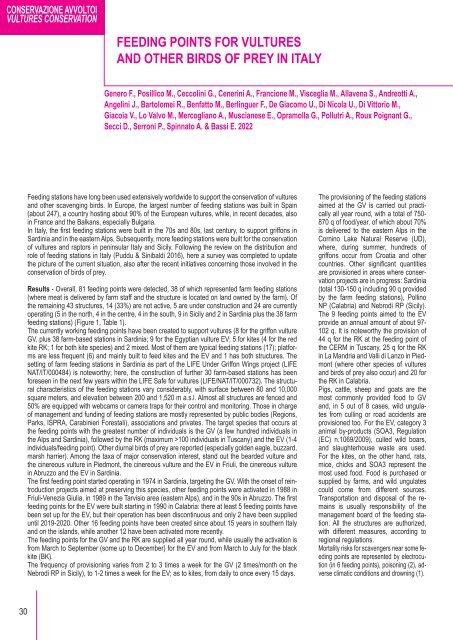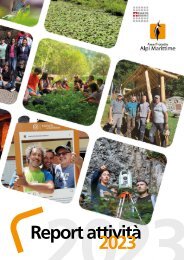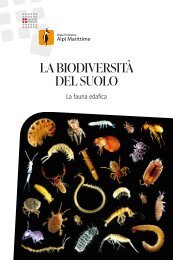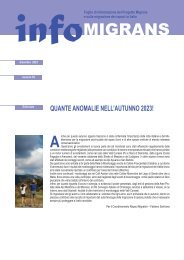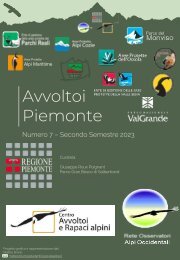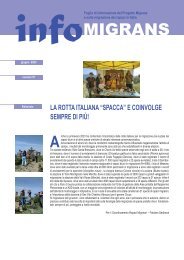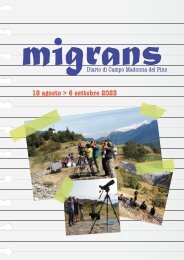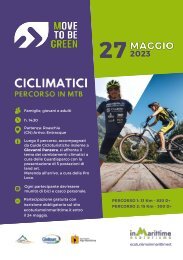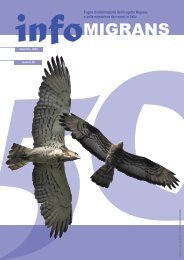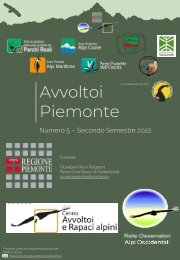infoGIPETO n.38 |dicembre 2021
Periodico d'informazione sul progetto di reintroduzione del gipeto.
Periodico d'informazione sul progetto di reintroduzione del gipeto.
- No tags were found...
You also want an ePaper? Increase the reach of your titles
YUMPU automatically turns print PDFs into web optimized ePapers that Google loves.
CONSERVAZIONE AVVOLTOI<br />
VULTURES CONSERVATION<br />
FEEDING POINTS FOR VULTURES<br />
AND OTHER BIRDS OF PREY IN ITALY<br />
Genero F., Posillico M., Ceccolini G., Cenerini A., Francione M., Visceglia M., Allavena S., Andreotti A.,<br />
Angelini J., Bartolomei R., Benfatto M., Berlinguer F., De Giacomo U., Di Nicola U., Di Vittorio M.,<br />
Giacoia V., Lo Valvo M., Mercogliano A., Muscianese E., Opramolla G., Pollutri A., Roux Poignant G.,<br />
Secci D., Serroni P., Spinnato A. & Bassi E. 2022<br />
Feeding stations have long been used extensively worldwide to support the conservation of vultures<br />
and other scavenging birds. In Europe, the largest number of feeding stations was built in Spain<br />
(about 247), a country hosting about 90% of the European vultures, while, in recent decades, also<br />
in France and the Balkans, especially Bulgaria.<br />
In Italy, the first feeding stations were built in the 70s and 80s, last century, to support griffons in<br />
Sardinia and in the eastern Alps. Subsequently, more feeding stations were built for the conservation<br />
of vultures and raptors in peninsular Italy and Sicily. Following the review on the distribution and<br />
role of feeding stations in Italy (Puddu & Sinibaldi 2016), here a survey was completed to update<br />
the picture of the current situation, also after the recent initiatives concerning those involved in the<br />
conservation of birds of prey.<br />
Results - Overall, 81 feeding points were detected, 38 of which represented farm feeding stations<br />
(where meat is delivered by farm staff and the structure is located on land owned by the farm). Of<br />
the remaining 43 structures, 14 (33%) are not active, 5 are under construction and 24 are currently<br />
operating (5 in the north, 4 in the centre, 4 in the south, 9 in Sicily and 2 in Sardinia plus the 38 farm<br />
feeding stations) (Figure 1, Table 1).<br />
The currently working feeding points have been created to support vultures (8 for the griffon vulture<br />
GV, plus 38 farm-based stations in Sardinia; 9 for the Egyptian vulture EV; 5 for kites (4 for the red<br />
kite RK; 1 for both kite species) and 2 mixed. Most of them are typical feeding stations (17); platforms<br />
are less frequent (6) and mainly built to feed kites and the EV and 1 has both structures. The<br />
setting of farm feeding stations in Sardinia as part of the LIFE Under Griffon Wings project (LIFE<br />
NAT/IT/000484) is noteworthy; here, the construction of further 30 farm-based stations has been<br />
foreseen in the next few years within the LIFE Safe for vultures (LIFE/NAT/IT/000732). The structural<br />
characteristics of the feeding stations vary considerably, with surface between 80 and 10,000<br />
square meters, and elevation between 200 and 1,520 m a.s.l. Almost all structures are fenced and<br />
50% are equipped with webcams or camera traps for their control and monitoring. Those in charge<br />
of management and funding of feeding stations are mostly represented by public bodies (Regions,<br />
Parks, ISPRA, Carabinieri Forestali), associations and privates. The target species that occurs at<br />
the feeding points with the greatest number of individuals is the GV (a few hundred individuals in<br />
the Alps and Sardinia), followed by the RK (maximum >100 individuals in Tuscany) and the EV (1-4<br />
individuals/feeding point). Other diurnal birds of prey are reported (especially golden eagle, buzzard,<br />
marsh harrier). Among the taxa of major conservation interest, stand out the bearded vulture and<br />
the cinereous vulture in Piedmont, the cinereous vulture and the EV in Friuli, the cinereous vulture<br />
in Abruzzo and the EV in Sardinia.<br />
The first feeding point started operating in 1974 in Sardinia, targeting the GV. With the onset of reintroduction<br />
projects aimed at preserving this species, other feeding points were activated in 1988 in<br />
Friuli-Venezia Giulia, in 1989 in the Tarvisio area (eastern Alps), and in the 90s in Abruzzo. The first<br />
feeding points for the EV were built starting in 1990 in Calabria: there at least 5 feeding points have<br />
been set up for the EV, but their operation has been discontinuous and only 2 have been supplied<br />
until 2019-2020. Other 16 feeding points have been created since about 15 years in southern Italy<br />
and on the islands, while another 12 have been activated more recently.<br />
The feeding points for the GV and the RK are supplied all year round, while usually the activation is<br />
from March to September (some up to December) for the EV and from March to July for the black<br />
kite (BK).<br />
The frequency of provisioning varies from 2 to 3 times a week for the GV (2 times/month on the<br />
Nebrodi RP in Sicily), to 1-2 times a week for the EV; as to kites, from daily to once every 15 days.<br />
The provisioning of the feeding stations<br />
aimed at the GV is carried out practically<br />
all year round, with a total of 750-<br />
870 q of food/year, of which about 70%<br />
is delivered to the eastern Alps in the<br />
Cornino Lake Natural Reserve (UD),<br />
where, during summer, hundreds of<br />
griffons occur from Croatia and other<br />
countries. Other significant quantities<br />
are provisioned in areas where conservation<br />
projects are in progress: Sardinia<br />
(total 130-150 q including 90 q provided<br />
by the farm feeding stations), Pollino<br />
NP (Calabria) and Nebrodi RP (Sicily).<br />
The 9 feeding points aimed to the EV<br />
provide an annual amount of about 97-<br />
102 q. It is noteworthy the provision of<br />
44 q for the RK at the feeding point of<br />
the CERM in Tuscany, 25 q for the RK<br />
in La Mandria and Valli di Lanzo in Piedmont<br />
(where other species of vultures<br />
and birds of prey also occur) and 20 for<br />
the RK in Calabria.<br />
Pigs, cattle, sheep and goats are the<br />
most commonly provided food to GV<br />
and, in 5 out of 8 cases, wild ungulates<br />
from culling or road accidents are<br />
provisioned too. For the EV, category 3<br />
animal by-products (SOA3, Regulation<br />
(EC) n.1069/2009), culled wild boars,<br />
and slaughterhouse waste are used.<br />
For the kites, on the other hand, rats,<br />
mice, chicks and SOA3 represent the<br />
most used food. Food is purchased or<br />
supplied by farms, and wild ungulates<br />
could come from different sources.<br />
Transportation and disposal of the remains<br />
is usually responsibility of the<br />
management board of the feeding station.<br />
All the structures are authorized,<br />
with different measures, according to<br />
regional regulations.<br />
Mortality risks for scavengers near some feeding<br />
points are represented by electrocution<br />
(in 6 feeding points), poisoning (2), adverse<br />
climatic conditions and drowning (1).<br />
30


